Determining Digital Transformation Steps and Business Impact on Wiser
VerifiedAdded on 2020/11/23
|24
|5357
|259
Report
AI Summary
This research project investigates the steps involved in digital transformation and their impact on business activities, using Wiser, a recruitment consultancy, as a case study. The report begins by outlining the research aim, rationale, questions, and objectives, emphasizing the significance of digital transformation in today's business landscape. It then provides a comprehensive literature review, exploring the concept of digital transformation, its key steps (including identifying objectives, studying technology enablers, envisioning a digital platform, mastering the digital services lifecycle, organizing for innovation, and executing an agile journey), and its importance for businesses like Wiser. The methodology chapter details the research approach, strategy, and ethical considerations. The findings, discussion, and conclusion sections analyze the collected data, interpret the results, and offer recommendations for further research, highlighting the importance of digital transformation for businesses to remain competitive and meet evolving customer expectations. The report emphasizes how digital transformation can enhance efficiency, improve customer experiences, and enable companies like Wiser to adapt to the changing business environment.

RESEARCH PROJECT
Paraphrase This Document
Need a fresh take? Get an instant paraphrase of this document with our AI Paraphraser
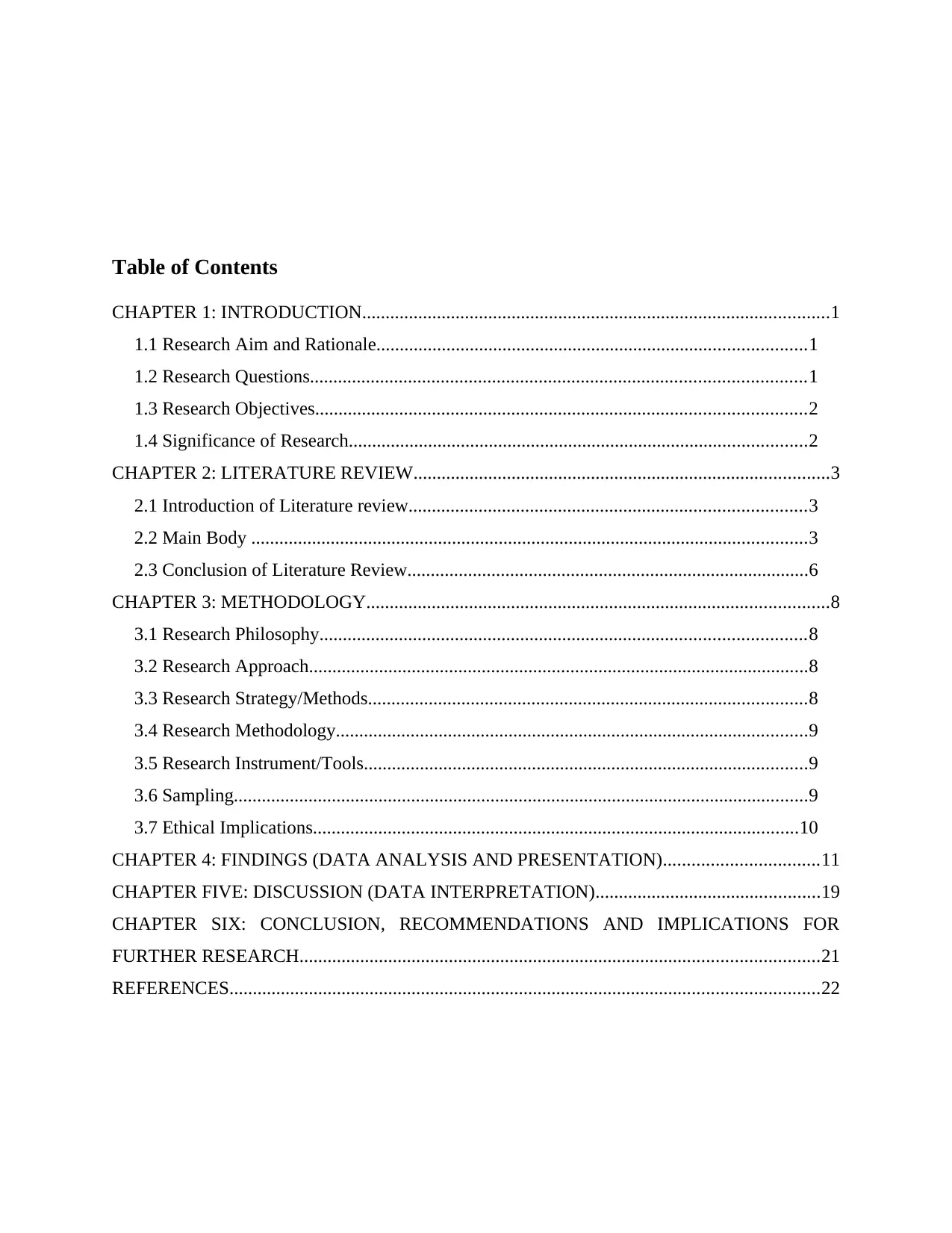
Table of Contents
CHAPTER 1: INTRODUCTION....................................................................................................1
1.1 Research Aim and Rationale............................................................................................1
1.2 Research Questions..........................................................................................................1
1.3 Research Objectives.........................................................................................................2
1.4 Significance of Research..................................................................................................2
CHAPTER 2: LITERATURE REVIEW.........................................................................................3
2.1 Introduction of Literature review.....................................................................................3
2.2 Main Body .......................................................................................................................3
2.3 Conclusion of Literature Review......................................................................................6
CHAPTER 3: METHODOLOGY...................................................................................................8
3.1 Research Philosophy........................................................................................................8
3.2 Research Approach...........................................................................................................8
3.3 Research Strategy/Methods..............................................................................................8
3.4 Research Methodology.....................................................................................................9
3.5 Research Instrument/Tools...............................................................................................9
3.6 Sampling...........................................................................................................................9
3.7 Ethical Implications........................................................................................................10
CHAPTER 4: FINDINGS (DATA ANALYSIS AND PRESENTATION).................................11
CHAPTER FIVE: DISCUSSION (DATA INTERPRETATION)................................................19
CHAPTER SIX: CONCLUSION, RECOMMENDATIONS AND IMPLICATIONS FOR
FURTHER RESEARCH...............................................................................................................21
REFERENCES..............................................................................................................................22
CHAPTER 1: INTRODUCTION....................................................................................................1
1.1 Research Aim and Rationale............................................................................................1
1.2 Research Questions..........................................................................................................1
1.3 Research Objectives.........................................................................................................2
1.4 Significance of Research..................................................................................................2
CHAPTER 2: LITERATURE REVIEW.........................................................................................3
2.1 Introduction of Literature review.....................................................................................3
2.2 Main Body .......................................................................................................................3
2.3 Conclusion of Literature Review......................................................................................6
CHAPTER 3: METHODOLOGY...................................................................................................8
3.1 Research Philosophy........................................................................................................8
3.2 Research Approach...........................................................................................................8
3.3 Research Strategy/Methods..............................................................................................8
3.4 Research Methodology.....................................................................................................9
3.5 Research Instrument/Tools...............................................................................................9
3.6 Sampling...........................................................................................................................9
3.7 Ethical Implications........................................................................................................10
CHAPTER 4: FINDINGS (DATA ANALYSIS AND PRESENTATION).................................11
CHAPTER FIVE: DISCUSSION (DATA INTERPRETATION)................................................19
CHAPTER SIX: CONCLUSION, RECOMMENDATIONS AND IMPLICATIONS FOR
FURTHER RESEARCH...............................................................................................................21
REFERENCES..............................................................................................................................22
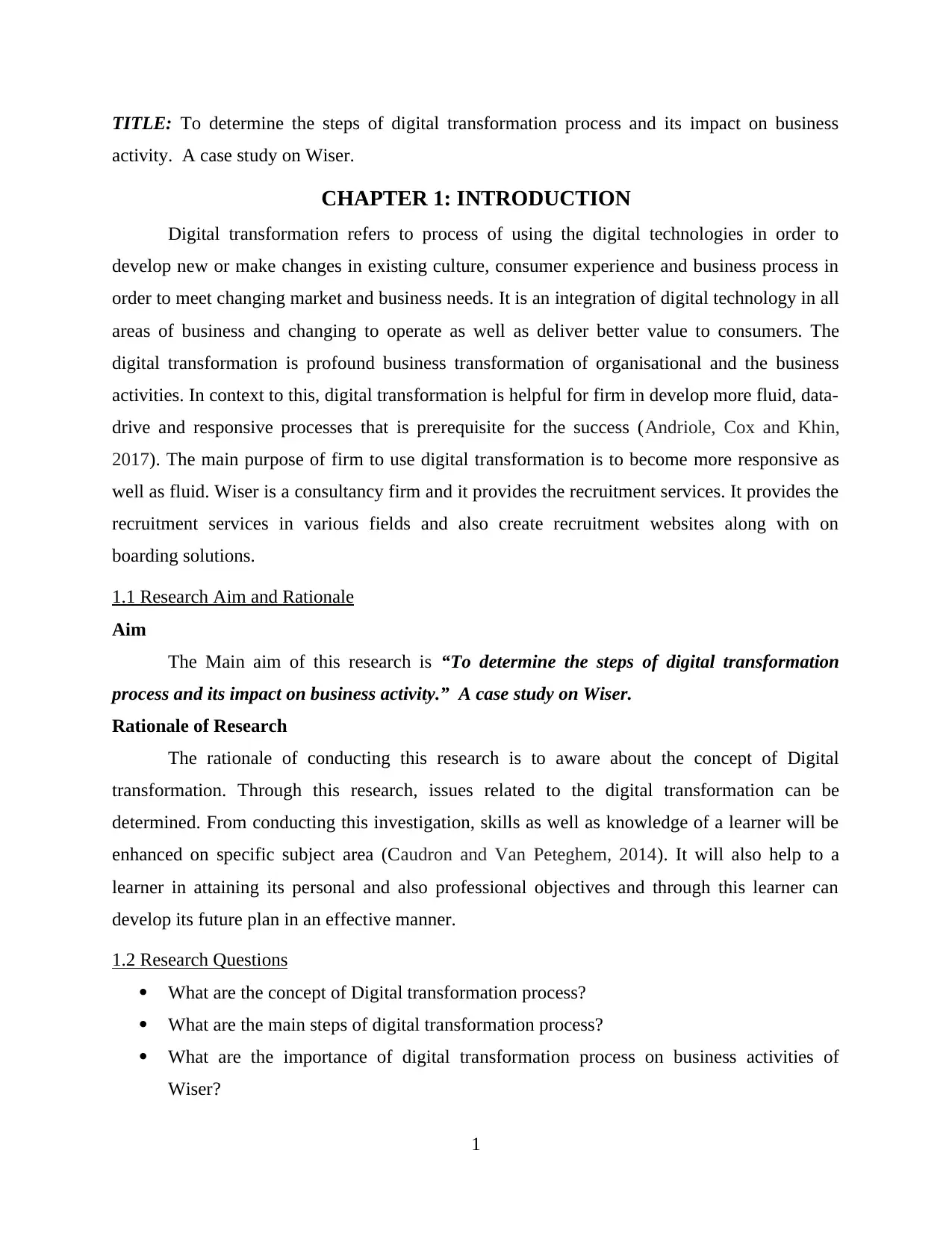
TITLE: To determine the steps of digital transformation process and its impact on business
activity. A case study on Wiser.
CHAPTER 1: INTRODUCTION
Digital transformation refers to process of using the digital technologies in order to
develop new or make changes in existing culture, consumer experience and business process in
order to meet changing market and business needs. It is an integration of digital technology in all
areas of business and changing to operate as well as deliver better value to consumers. The
digital transformation is profound business transformation of organisational and the business
activities. In context to this, digital transformation is helpful for firm in develop more fluid, data-
drive and responsive processes that is prerequisite for the success (Andriole, Cox and Khin,
2017). The main purpose of firm to use digital transformation is to become more responsive as
well as fluid. Wiser is a consultancy firm and it provides the recruitment services. It provides the
recruitment services in various fields and also create recruitment websites along with on
boarding solutions.
1.1 Research Aim and Rationale
Aim
The Main aim of this research is “To determine the steps of digital transformation
process and its impact on business activity.” A case study on Wiser.
Rationale of Research
The rationale of conducting this research is to aware about the concept of Digital
transformation. Through this research, issues related to the digital transformation can be
determined. From conducting this investigation, skills as well as knowledge of a learner will be
enhanced on specific subject area (Caudron and Van Peteghem, 2014). It will also help to a
learner in attaining its personal and also professional objectives and through this learner can
develop its future plan in an effective manner.
1.2 Research Questions
What are the concept of Digital transformation process?
What are the main steps of digital transformation process?
What are the importance of digital transformation process on business activities of
Wiser?
1
activity. A case study on Wiser.
CHAPTER 1: INTRODUCTION
Digital transformation refers to process of using the digital technologies in order to
develop new or make changes in existing culture, consumer experience and business process in
order to meet changing market and business needs. It is an integration of digital technology in all
areas of business and changing to operate as well as deliver better value to consumers. The
digital transformation is profound business transformation of organisational and the business
activities. In context to this, digital transformation is helpful for firm in develop more fluid, data-
drive and responsive processes that is prerequisite for the success (Andriole, Cox and Khin,
2017). The main purpose of firm to use digital transformation is to become more responsive as
well as fluid. Wiser is a consultancy firm and it provides the recruitment services. It provides the
recruitment services in various fields and also create recruitment websites along with on
boarding solutions.
1.1 Research Aim and Rationale
Aim
The Main aim of this research is “To determine the steps of digital transformation
process and its impact on business activity.” A case study on Wiser.
Rationale of Research
The rationale of conducting this research is to aware about the concept of Digital
transformation. Through this research, issues related to the digital transformation can be
determined. From conducting this investigation, skills as well as knowledge of a learner will be
enhanced on specific subject area (Caudron and Van Peteghem, 2014). It will also help to a
learner in attaining its personal and also professional objectives and through this learner can
develop its future plan in an effective manner.
1.2 Research Questions
What are the concept of Digital transformation process?
What are the main steps of digital transformation process?
What are the importance of digital transformation process on business activities of
Wiser?
1
⊘ This is a preview!⊘
Do you want full access?
Subscribe today to unlock all pages.

Trusted by 1+ million students worldwide
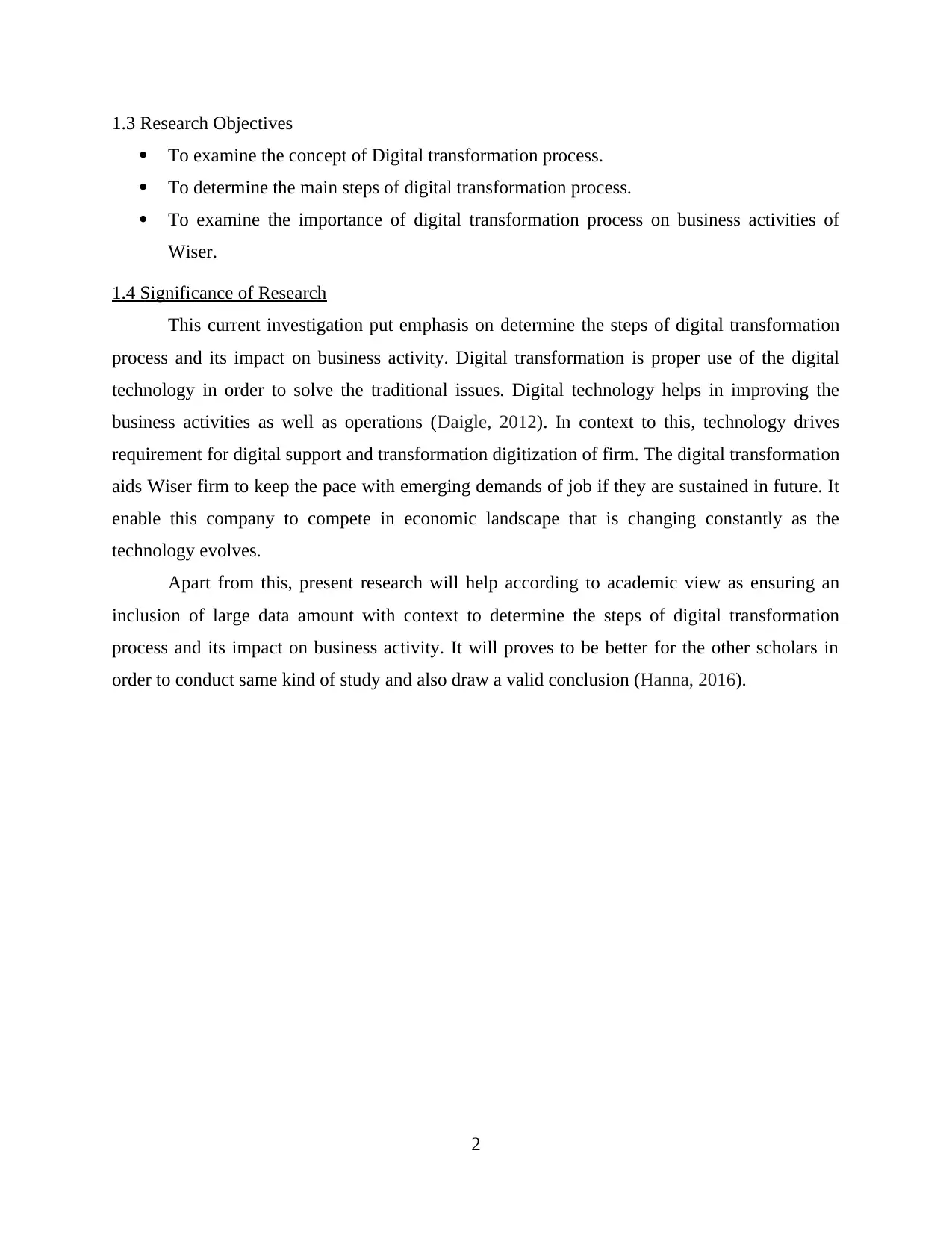
1.3 Research Objectives
To examine the concept of Digital transformation process.
To determine the main steps of digital transformation process.
To examine the importance of digital transformation process on business activities of
Wiser.
1.4 Significance of Research
This current investigation put emphasis on determine the steps of digital transformation
process and its impact on business activity. Digital transformation is proper use of the digital
technology in order to solve the traditional issues. Digital technology helps in improving the
business activities as well as operations (Daigle, 2012). In context to this, technology drives
requirement for digital support and transformation digitization of firm. The digital transformation
aids Wiser firm to keep the pace with emerging demands of job if they are sustained in future. It
enable this company to compete in economic landscape that is changing constantly as the
technology evolves.
Apart from this, present research will help according to academic view as ensuring an
inclusion of large data amount with context to determine the steps of digital transformation
process and its impact on business activity. It will proves to be better for the other scholars in
order to conduct same kind of study and also draw a valid conclusion (Hanna, 2016).
2
To examine the concept of Digital transformation process.
To determine the main steps of digital transformation process.
To examine the importance of digital transformation process on business activities of
Wiser.
1.4 Significance of Research
This current investigation put emphasis on determine the steps of digital transformation
process and its impact on business activity. Digital transformation is proper use of the digital
technology in order to solve the traditional issues. Digital technology helps in improving the
business activities as well as operations (Daigle, 2012). In context to this, technology drives
requirement for digital support and transformation digitization of firm. The digital transformation
aids Wiser firm to keep the pace with emerging demands of job if they are sustained in future. It
enable this company to compete in economic landscape that is changing constantly as the
technology evolves.
Apart from this, present research will help according to academic view as ensuring an
inclusion of large data amount with context to determine the steps of digital transformation
process and its impact on business activity. It will proves to be better for the other scholars in
order to conduct same kind of study and also draw a valid conclusion (Hanna, 2016).
2
Paraphrase This Document
Need a fresh take? Get an instant paraphrase of this document with our AI Paraphraser

CHAPTER 2: LITERATURE REVIEW
2.1 Introduction of Literature review
Under this part of research, there is a need to an investigator to conduct an in- depth
information review that published through using the secondary sources. It is necessary to conduct
the better analysis of previous information and literature that is extracted by using secondary
sources. In order to conducting this research part, investigator uses the secondary sources for an
instance books, articles, journals, magazines etc. The literature review is explanation as well as
summary of present knowledge state on specific area that is found in journals, academic books
etc.
2.2 Main Body
Concept of Digital transformation process
According to opinion of Clint Boulton (2019) it has been stated that digital
transformation refers to profound business transformation as well as organisational process,
models and activities in order to leverage opportunities and changes of mix digital technologies.
It allows the business to capitalise on the opportunities which are presented through digital
technology. In this, it alters processes as well as activities for leverage opportunities which are
presented through digital technology. The digital transformation is change that is related with the
integration as well as application of digital technology in all aspects of organisation and society.
The main aim of digital transformation is to develop capabilities of possibilities as well as
leveraging the new opportunities related to advanced technologies and their fast impact. The
digital transformation is use of the high digital technology in order to solve the traditional
problems. Under this, digital solutions enable new kind of creativity as well as innovation in
order to support the traditional methods.
On the basis of opinion of Oleksandr Tedikov (2019), Digital transformation is viewed as
execution of the digital technologies in to business areas in context to develop better sustainable
relationship and understand requirements of consumers. The digital transformation is regarding
making the things simple or easier and also engage the consumers at every touch point. For
business, digital transformation is opportunity as well as challenge. When firm is planning for
the digital transformation, it is necessary for firm to consider cultural changes that they will be
confront as leaders to organisation in order to adopting unfamiliar technologies. It has developed
3
2.1 Introduction of Literature review
Under this part of research, there is a need to an investigator to conduct an in- depth
information review that published through using the secondary sources. It is necessary to conduct
the better analysis of previous information and literature that is extracted by using secondary
sources. In order to conducting this research part, investigator uses the secondary sources for an
instance books, articles, journals, magazines etc. The literature review is explanation as well as
summary of present knowledge state on specific area that is found in journals, academic books
etc.
2.2 Main Body
Concept of Digital transformation process
According to opinion of Clint Boulton (2019) it has been stated that digital
transformation refers to profound business transformation as well as organisational process,
models and activities in order to leverage opportunities and changes of mix digital technologies.
It allows the business to capitalise on the opportunities which are presented through digital
technology. In this, it alters processes as well as activities for leverage opportunities which are
presented through digital technology. The digital transformation is change that is related with the
integration as well as application of digital technology in all aspects of organisation and society.
The main aim of digital transformation is to develop capabilities of possibilities as well as
leveraging the new opportunities related to advanced technologies and their fast impact. The
digital transformation is use of the high digital technology in order to solve the traditional
problems. Under this, digital solutions enable new kind of creativity as well as innovation in
order to support the traditional methods.
On the basis of opinion of Oleksandr Tedikov (2019), Digital transformation is viewed as
execution of the digital technologies in to business areas in context to develop better sustainable
relationship and understand requirements of consumers. The digital transformation is regarding
making the things simple or easier and also engage the consumers at every touch point. For
business, digital transformation is opportunity as well as challenge. When firm is planning for
the digital transformation, it is necessary for firm to consider cultural changes that they will be
confront as leaders to organisation in order to adopting unfamiliar technologies. It has developed
3

many opportunities for business so that firm can deal with its competitors at market place. On the
other hand, digital transformation is adoption of digital tools and process for attaining the
strategic business objectives. Fundamentally, digital transformation changes how firms develop,
monetize, defend value and also providing the competitive edge to business.
Main steps of digital transformation process
On the basis of opinion of Nicholas D. Evans (2019) Digital transformation refers to use
of the new age technologies over process of traditional business in order to develop scalable
innovation, growth and optimization process. It is radically transforming global business
landscape. It consists IoT, Analytics, Social Platforms etc. for enhance performance of business.
Under this, there are some steps in digital transformation process mention below:
Step 1: Identify your transformation objectives- It is a first step in process of digital
transformation. It is necessary for strategy to set stake in ground in context of the outcomes
related to business target. Under this, there are two mistakes firm make when adopting the new
technologies. First is that they adopt the technology through its innovation through some other
departments. They can involve the new applicants than the other competitors and some of the
other players in an industry have to be adopted. On the other hand, second mistake that they
begin with their capabilities without having any kind of objectives. These kind of mistakes can
be solved to soiled as well as isolated adoption of technologies which are complex to be integrate
throughout whole firm. So, it is necessary for Wiser company to determine its transformation
objectives in a better manner.
Step 2: Study technology enablers in the market- It is a next step and there is a need to
aware and leverage about technology enablers at market place. Under this, advance cybersecurity
is main key enabler because when the merging technologies are bot secure from beginning
delays will be creates in relating business benefits as firm struggle for execute the proper security
controls. In context to recent enablers, core SMAC is clearly evolved in this.
Step 3: Envision the future platform for digital business- The Foundational technology
enablers can be use for assemble high virtualised and more distributed platform of on demand
services. On the basis of perspective, there is a need for company to choose more powerful
combination of technologies in order to attain the target of business like increasing digital
workplace., improving digital experience of consumers etc.
4
other hand, digital transformation is adoption of digital tools and process for attaining the
strategic business objectives. Fundamentally, digital transformation changes how firms develop,
monetize, defend value and also providing the competitive edge to business.
Main steps of digital transformation process
On the basis of opinion of Nicholas D. Evans (2019) Digital transformation refers to use
of the new age technologies over process of traditional business in order to develop scalable
innovation, growth and optimization process. It is radically transforming global business
landscape. It consists IoT, Analytics, Social Platforms etc. for enhance performance of business.
Under this, there are some steps in digital transformation process mention below:
Step 1: Identify your transformation objectives- It is a first step in process of digital
transformation. It is necessary for strategy to set stake in ground in context of the outcomes
related to business target. Under this, there are two mistakes firm make when adopting the new
technologies. First is that they adopt the technology through its innovation through some other
departments. They can involve the new applicants than the other competitors and some of the
other players in an industry have to be adopted. On the other hand, second mistake that they
begin with their capabilities without having any kind of objectives. These kind of mistakes can
be solved to soiled as well as isolated adoption of technologies which are complex to be integrate
throughout whole firm. So, it is necessary for Wiser company to determine its transformation
objectives in a better manner.
Step 2: Study technology enablers in the market- It is a next step and there is a need to
aware and leverage about technology enablers at market place. Under this, advance cybersecurity
is main key enabler because when the merging technologies are bot secure from beginning
delays will be creates in relating business benefits as firm struggle for execute the proper security
controls. In context to recent enablers, core SMAC is clearly evolved in this.
Step 3: Envision the future platform for digital business- The Foundational technology
enablers can be use for assemble high virtualised and more distributed platform of on demand
services. On the basis of perspective, there is a need for company to choose more powerful
combination of technologies in order to attain the target of business like increasing digital
workplace., improving digital experience of consumers etc.
4
⊘ This is a preview!⊘
Do you want full access?
Subscribe today to unlock all pages.

Trusted by 1+ million students worldwide
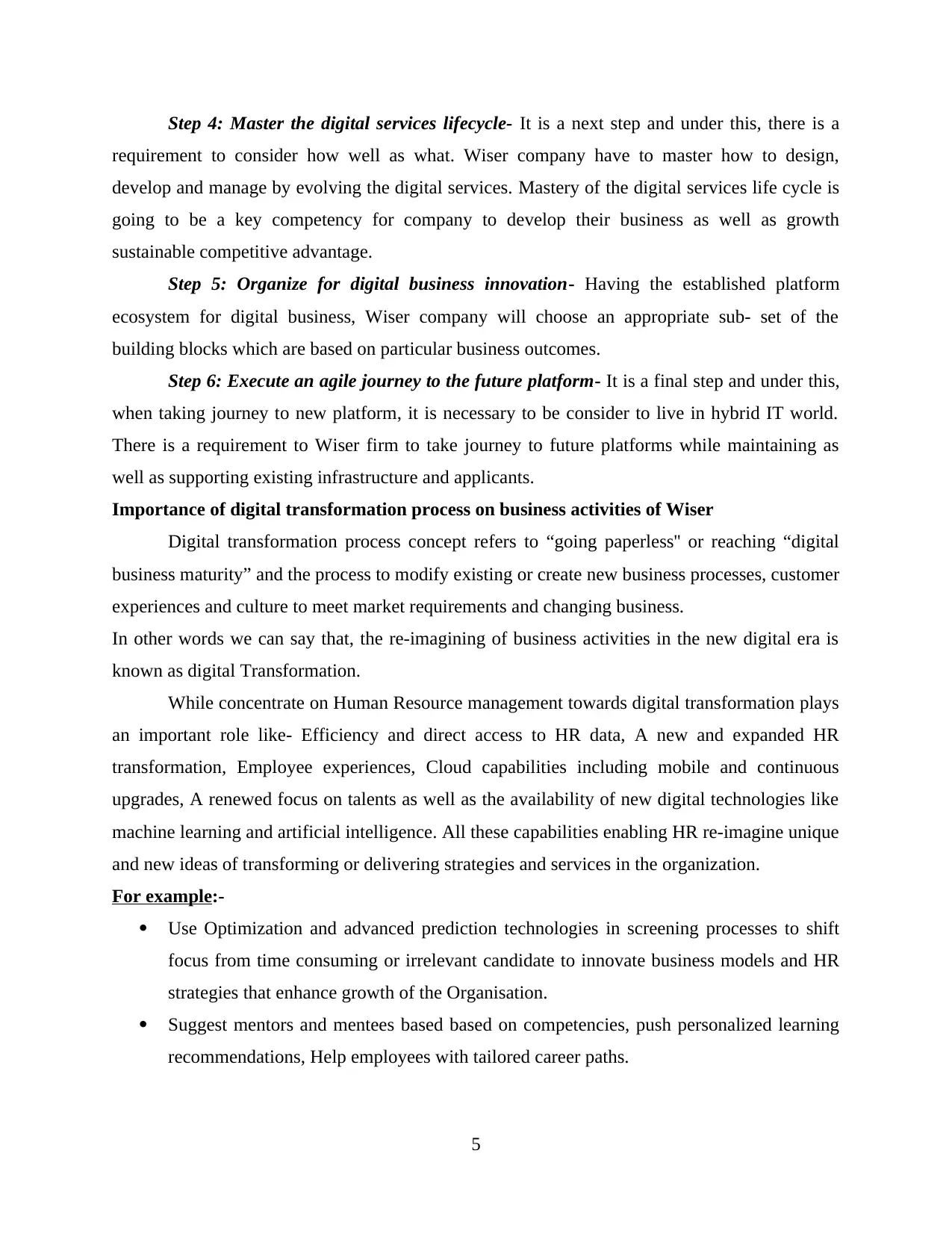
Step 4: Master the digital services lifecycle- It is a next step and under this, there is a
requirement to consider how well as what. Wiser company have to master how to design,
develop and manage by evolving the digital services. Mastery of the digital services life cycle is
going to be a key competency for company to develop their business as well as growth
sustainable competitive advantage.
Step 5: Organize for digital business innovation- Having the established platform
ecosystem for digital business, Wiser company will choose an appropriate sub- set of the
building blocks which are based on particular business outcomes.
Step 6: Execute an agile journey to the future platform- It is a final step and under this,
when taking journey to new platform, it is necessary to be consider to live in hybrid IT world.
There is a requirement to Wiser firm to take journey to future platforms while maintaining as
well as supporting existing infrastructure and applicants.
Importance of digital transformation process on business activities of Wiser
Digital transformation process concept refers to “going paperless'' or reaching “digital
business maturity” and the process to modify existing or create new business processes, customer
experiences and culture to meet market requirements and changing business.
In other words we can say that, the re-imagining of business activities in the new digital era is
known as digital Transformation.
While concentrate on Human Resource management towards digital transformation plays
an important role like- Efficiency and direct access to HR data, A new and expanded HR
transformation, Employee experiences, Cloud capabilities including mobile and continuous
upgrades, A renewed focus on talents as well as the availability of new digital technologies like
machine learning and artificial intelligence. All these capabilities enabling HR re-imagine unique
and new ideas of transforming or delivering strategies and services in the organization.
For example:-
Use Optimization and advanced prediction technologies in screening processes to shift
focus from time consuming or irrelevant candidate to innovate business models and HR
strategies that enhance growth of the Organisation.
Suggest mentors and mentees based based on competencies, push personalized learning
recommendations, Help employees with tailored career paths.
5
requirement to consider how well as what. Wiser company have to master how to design,
develop and manage by evolving the digital services. Mastery of the digital services life cycle is
going to be a key competency for company to develop their business as well as growth
sustainable competitive advantage.
Step 5: Organize for digital business innovation- Having the established platform
ecosystem for digital business, Wiser company will choose an appropriate sub- set of the
building blocks which are based on particular business outcomes.
Step 6: Execute an agile journey to the future platform- It is a final step and under this,
when taking journey to new platform, it is necessary to be consider to live in hybrid IT world.
There is a requirement to Wiser firm to take journey to future platforms while maintaining as
well as supporting existing infrastructure and applicants.
Importance of digital transformation process on business activities of Wiser
Digital transformation process concept refers to “going paperless'' or reaching “digital
business maturity” and the process to modify existing or create new business processes, customer
experiences and culture to meet market requirements and changing business.
In other words we can say that, the re-imagining of business activities in the new digital era is
known as digital Transformation.
While concentrate on Human Resource management towards digital transformation plays
an important role like- Efficiency and direct access to HR data, A new and expanded HR
transformation, Employee experiences, Cloud capabilities including mobile and continuous
upgrades, A renewed focus on talents as well as the availability of new digital technologies like
machine learning and artificial intelligence. All these capabilities enabling HR re-imagine unique
and new ideas of transforming or delivering strategies and services in the organization.
For example:-
Use Optimization and advanced prediction technologies in screening processes to shift
focus from time consuming or irrelevant candidate to innovate business models and HR
strategies that enhance growth of the Organisation.
Suggest mentors and mentees based based on competencies, push personalized learning
recommendations, Help employees with tailored career paths.
5
Paraphrase This Document
Need a fresh take? Get an instant paraphrase of this document with our AI Paraphraser
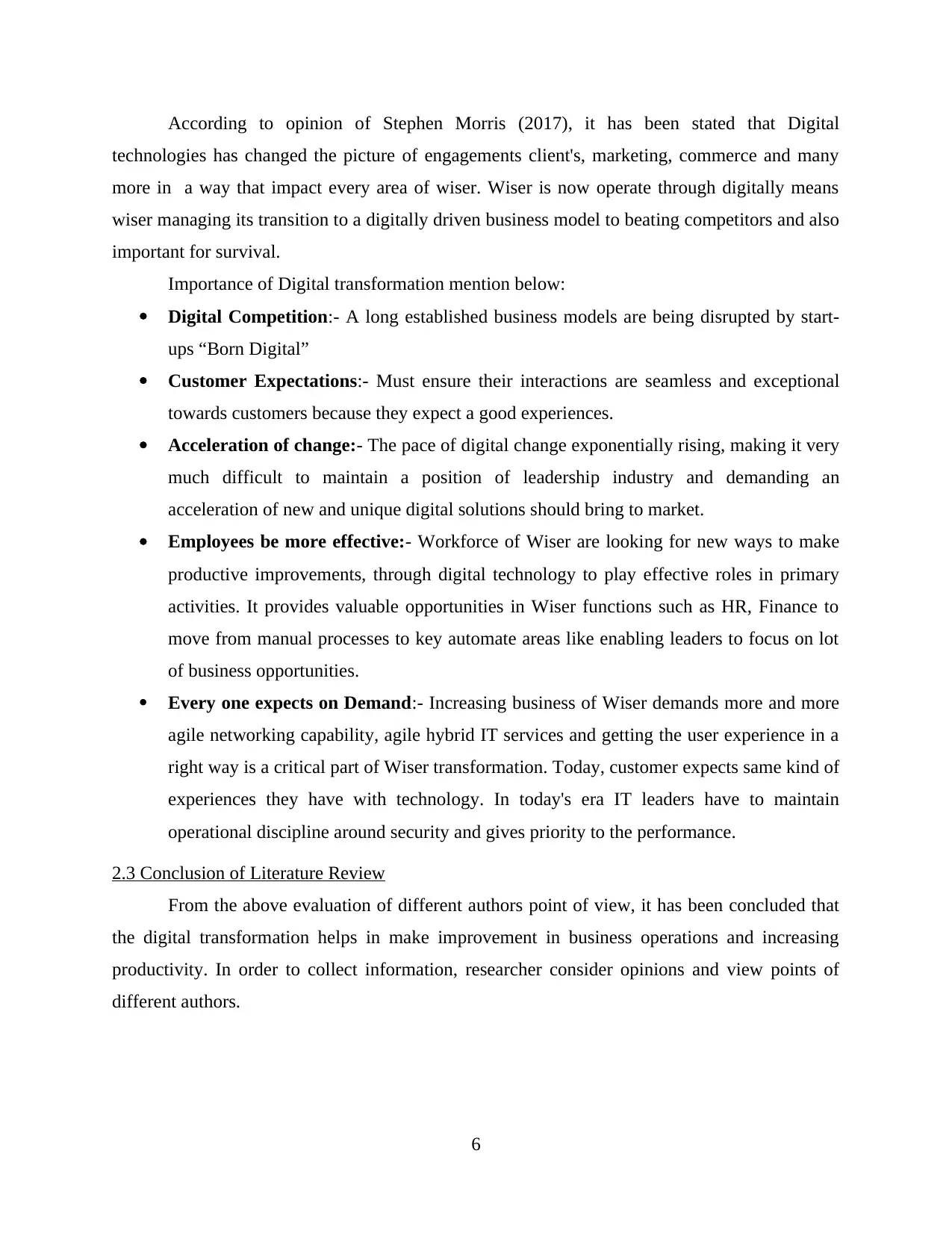
According to opinion of Stephen Morris (2017), it has been stated that Digital
technologies has changed the picture of engagements client's, marketing, commerce and many
more in a way that impact every area of wiser. Wiser is now operate through digitally means
wiser managing its transition to a digitally driven business model to beating competitors and also
important for survival.
Importance of Digital transformation mention below:
Digital Competition:- A long established business models are being disrupted by start-
ups “Born Digital”
Customer Expectations:- Must ensure their interactions are seamless and exceptional
towards customers because they expect a good experiences.
Acceleration of change:- The pace of digital change exponentially rising, making it very
much difficult to maintain a position of leadership industry and demanding an
acceleration of new and unique digital solutions should bring to market.
Employees be more effective:- Workforce of Wiser are looking for new ways to make
productive improvements, through digital technology to play effective roles in primary
activities. It provides valuable opportunities in Wiser functions such as HR, Finance to
move from manual processes to key automate areas like enabling leaders to focus on lot
of business opportunities.
Every one expects on Demand:- Increasing business of Wiser demands more and more
agile networking capability, agile hybrid IT services and getting the user experience in a
right way is a critical part of Wiser transformation. Today, customer expects same kind of
experiences they have with technology. In today's era IT leaders have to maintain
operational discipline around security and gives priority to the performance.
2.3 Conclusion of Literature Review
From the above evaluation of different authors point of view, it has been concluded that
the digital transformation helps in make improvement in business operations and increasing
productivity. In order to collect information, researcher consider opinions and view points of
different authors.
6
technologies has changed the picture of engagements client's, marketing, commerce and many
more in a way that impact every area of wiser. Wiser is now operate through digitally means
wiser managing its transition to a digitally driven business model to beating competitors and also
important for survival.
Importance of Digital transformation mention below:
Digital Competition:- A long established business models are being disrupted by start-
ups “Born Digital”
Customer Expectations:- Must ensure their interactions are seamless and exceptional
towards customers because they expect a good experiences.
Acceleration of change:- The pace of digital change exponentially rising, making it very
much difficult to maintain a position of leadership industry and demanding an
acceleration of new and unique digital solutions should bring to market.
Employees be more effective:- Workforce of Wiser are looking for new ways to make
productive improvements, through digital technology to play effective roles in primary
activities. It provides valuable opportunities in Wiser functions such as HR, Finance to
move from manual processes to key automate areas like enabling leaders to focus on lot
of business opportunities.
Every one expects on Demand:- Increasing business of Wiser demands more and more
agile networking capability, agile hybrid IT services and getting the user experience in a
right way is a critical part of Wiser transformation. Today, customer expects same kind of
experiences they have with technology. In today's era IT leaders have to maintain
operational discipline around security and gives priority to the performance.
2.3 Conclusion of Literature Review
From the above evaluation of different authors point of view, it has been concluded that
the digital transformation helps in make improvement in business operations and increasing
productivity. In order to collect information, researcher consider opinions and view points of
different authors.
6

CHAPTER 3: METHODOLOGY
Methodology refers to a systematic as well as theoretical analysis of methods which are
applied to area of study. It is comprises theoretical analysis of principles and methods body that
is related with the branch of knowledge (Hansen and Sia, 2015). It is a analysis of principles of
inquiry in specific field.
3.1 Research Philosophy
Research philosophy refers to set of beliefs which are concerning reality nature that is
being investigated. Under this, assumption developed through research philosophy give
justification for how an investigation will be undertaken (Weerakkody and Reddick, 2012).
Under this, there are two different types of research philosophies:
Positivism- It is suitable for research where mathematical as well as scientific models are
to be adopted for gathering and analysis of data and information. Under this, knowledge is based
on the natural phenomenon and also their relations and properties (Westerman, Bonnet and
McAfee, 2014).
Interpretivism- This kind of research philosophy relied on trained investigator as well as
human subject as instruments in order to measure some of the phenomenon and mainly includes
interviews as well as observations.
Among both philosophies, interpretivism is selected through researcher because under
this, investigator is able to conduct proper analysis in an effective manner (HKurti and Haftor,
2015).
3.2 Research Approach
It refers to process that includes steps of wider assumptions to the detailed data collection
method, analysis and interpretation. Different kinds of research approaches mention below:
Inductive approach- It is related with generation of the new theory that is emerging from
data. It is mainly use the research questions in order to narrow scope of study (Vom Brocke and
Mendling, 2018).
Deductive approach- It is based on causality and on quantitative research method.
This research is based on inductive research approach because it includes qualitative
method and also provides in depth analysis of information.
7
Methodology refers to a systematic as well as theoretical analysis of methods which are
applied to area of study. It is comprises theoretical analysis of principles and methods body that
is related with the branch of knowledge (Hansen and Sia, 2015). It is a analysis of principles of
inquiry in specific field.
3.1 Research Philosophy
Research philosophy refers to set of beliefs which are concerning reality nature that is
being investigated. Under this, assumption developed through research philosophy give
justification for how an investigation will be undertaken (Weerakkody and Reddick, 2012).
Under this, there are two different types of research philosophies:
Positivism- It is suitable for research where mathematical as well as scientific models are
to be adopted for gathering and analysis of data and information. Under this, knowledge is based
on the natural phenomenon and also their relations and properties (Westerman, Bonnet and
McAfee, 2014).
Interpretivism- This kind of research philosophy relied on trained investigator as well as
human subject as instruments in order to measure some of the phenomenon and mainly includes
interviews as well as observations.
Among both philosophies, interpretivism is selected through researcher because under
this, investigator is able to conduct proper analysis in an effective manner (HKurti and Haftor,
2015).
3.2 Research Approach
It refers to process that includes steps of wider assumptions to the detailed data collection
method, analysis and interpretation. Different kinds of research approaches mention below:
Inductive approach- It is related with generation of the new theory that is emerging from
data. It is mainly use the research questions in order to narrow scope of study (Vom Brocke and
Mendling, 2018).
Deductive approach- It is based on causality and on quantitative research method.
This research is based on inductive research approach because it includes qualitative
method and also provides in depth analysis of information.
7
⊘ This is a preview!⊘
Do you want full access?
Subscribe today to unlock all pages.

Trusted by 1+ million students worldwide
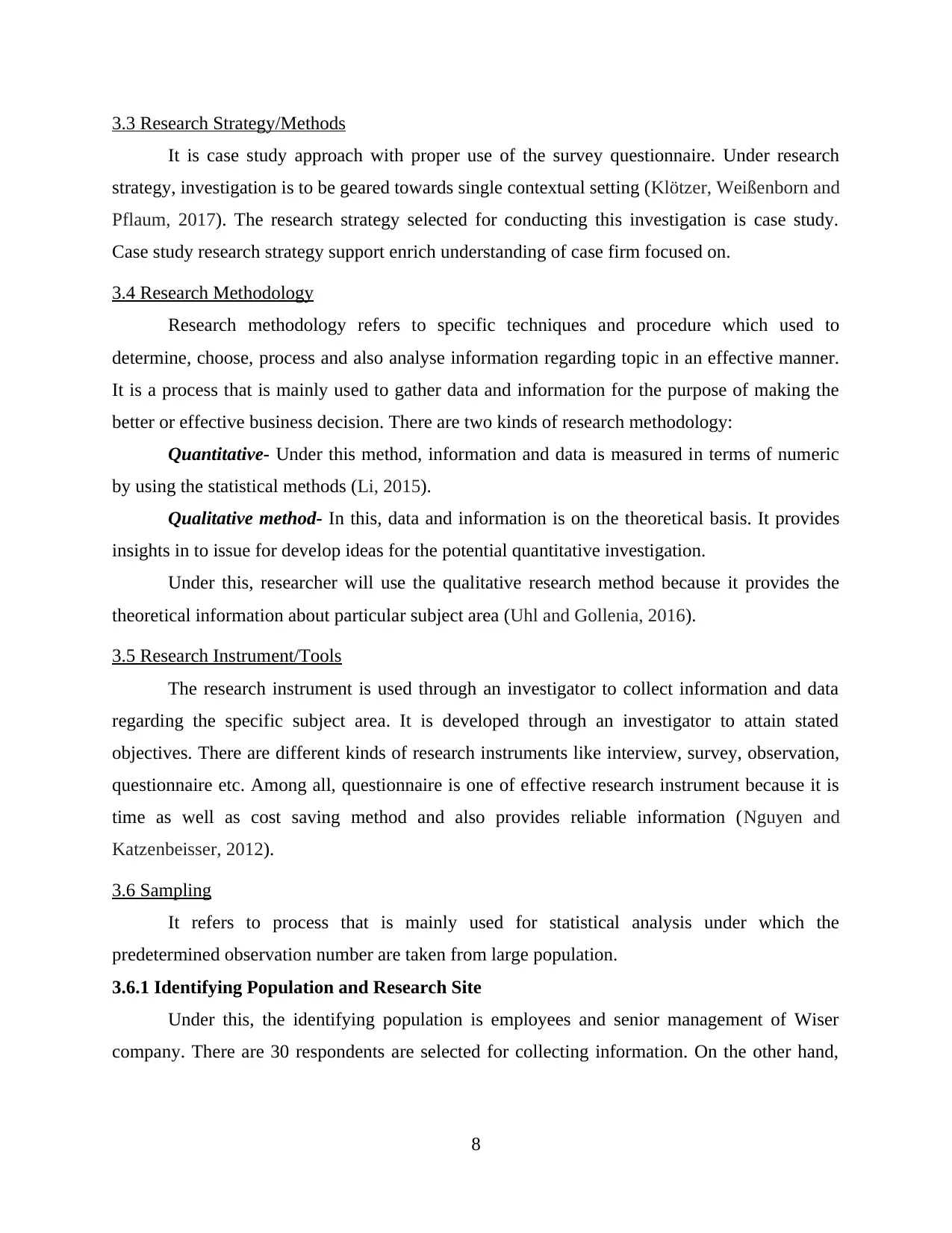
3.3 Research Strategy/Methods
It is case study approach with proper use of the survey questionnaire. Under research
strategy, investigation is to be geared towards single contextual setting (Klötzer, Weißenborn and
Pflaum, 2017). The research strategy selected for conducting this investigation is case study.
Case study research strategy support enrich understanding of case firm focused on.
3.4 Research Methodology
Research methodology refers to specific techniques and procedure which used to
determine, choose, process and also analyse information regarding topic in an effective manner.
It is a process that is mainly used to gather data and information for the purpose of making the
better or effective business decision. There are two kinds of research methodology:
Quantitative- Under this method, information and data is measured in terms of numeric
by using the statistical methods (Li, 2015).
Qualitative method- In this, data and information is on the theoretical basis. It provides
insights in to issue for develop ideas for the potential quantitative investigation.
Under this, researcher will use the qualitative research method because it provides the
theoretical information about particular subject area (Uhl and Gollenia, 2016).
3.5 Research Instrument/Tools
The research instrument is used through an investigator to collect information and data
regarding the specific subject area. It is developed through an investigator to attain stated
objectives. There are different kinds of research instruments like interview, survey, observation,
questionnaire etc. Among all, questionnaire is one of effective research instrument because it is
time as well as cost saving method and also provides reliable information (Nguyen and
Katzenbeisser, 2012).
3.6 Sampling
It refers to process that is mainly used for statistical analysis under which the
predetermined observation number are taken from large population.
3.6.1 Identifying Population and Research Site
Under this, the identifying population is employees and senior management of Wiser
company. There are 30 respondents are selected for collecting information. On the other hand,
8
It is case study approach with proper use of the survey questionnaire. Under research
strategy, investigation is to be geared towards single contextual setting (Klötzer, Weißenborn and
Pflaum, 2017). The research strategy selected for conducting this investigation is case study.
Case study research strategy support enrich understanding of case firm focused on.
3.4 Research Methodology
Research methodology refers to specific techniques and procedure which used to
determine, choose, process and also analyse information regarding topic in an effective manner.
It is a process that is mainly used to gather data and information for the purpose of making the
better or effective business decision. There are two kinds of research methodology:
Quantitative- Under this method, information and data is measured in terms of numeric
by using the statistical methods (Li, 2015).
Qualitative method- In this, data and information is on the theoretical basis. It provides
insights in to issue for develop ideas for the potential quantitative investigation.
Under this, researcher will use the qualitative research method because it provides the
theoretical information about particular subject area (Uhl and Gollenia, 2016).
3.5 Research Instrument/Tools
The research instrument is used through an investigator to collect information and data
regarding the specific subject area. It is developed through an investigator to attain stated
objectives. There are different kinds of research instruments like interview, survey, observation,
questionnaire etc. Among all, questionnaire is one of effective research instrument because it is
time as well as cost saving method and also provides reliable information (Nguyen and
Katzenbeisser, 2012).
3.6 Sampling
It refers to process that is mainly used for statistical analysis under which the
predetermined observation number are taken from large population.
3.6.1 Identifying Population and Research Site
Under this, the identifying population is employees and senior management of Wiser
company. There are 30 respondents are selected for collecting information. On the other hand,
8
Paraphrase This Document
Need a fresh take? Get an instant paraphrase of this document with our AI Paraphraser

research site refers to single firm that is mainly responsible for conducting an investigation at
specific locality. In this, research site is Wiser business firm (Sambamurthy and Zmud, 2012).
3.6.2 Sampling Strategy
For selecting the respondents from whole population, researcher uses random data
sampling strategy because it is not biased and also give equal chance to selected population.
3.7 Ethical Implications
Research includes the primary investigation and the research ethics were applied for
assure that outcomes of research are considered to relevant and robust (Schallmo and Williams,
2018). It is necessary for a research to follow all the research ethics principles like
confidentiality, informed consent etc. At the time of conducting an investigation.
9
specific locality. In this, research site is Wiser business firm (Sambamurthy and Zmud, 2012).
3.6.2 Sampling Strategy
For selecting the respondents from whole population, researcher uses random data
sampling strategy because it is not biased and also give equal chance to selected population.
3.7 Ethical Implications
Research includes the primary investigation and the research ethics were applied for
assure that outcomes of research are considered to relevant and robust (Schallmo and Williams,
2018). It is necessary for a research to follow all the research ethics principles like
confidentiality, informed consent etc. At the time of conducting an investigation.
9
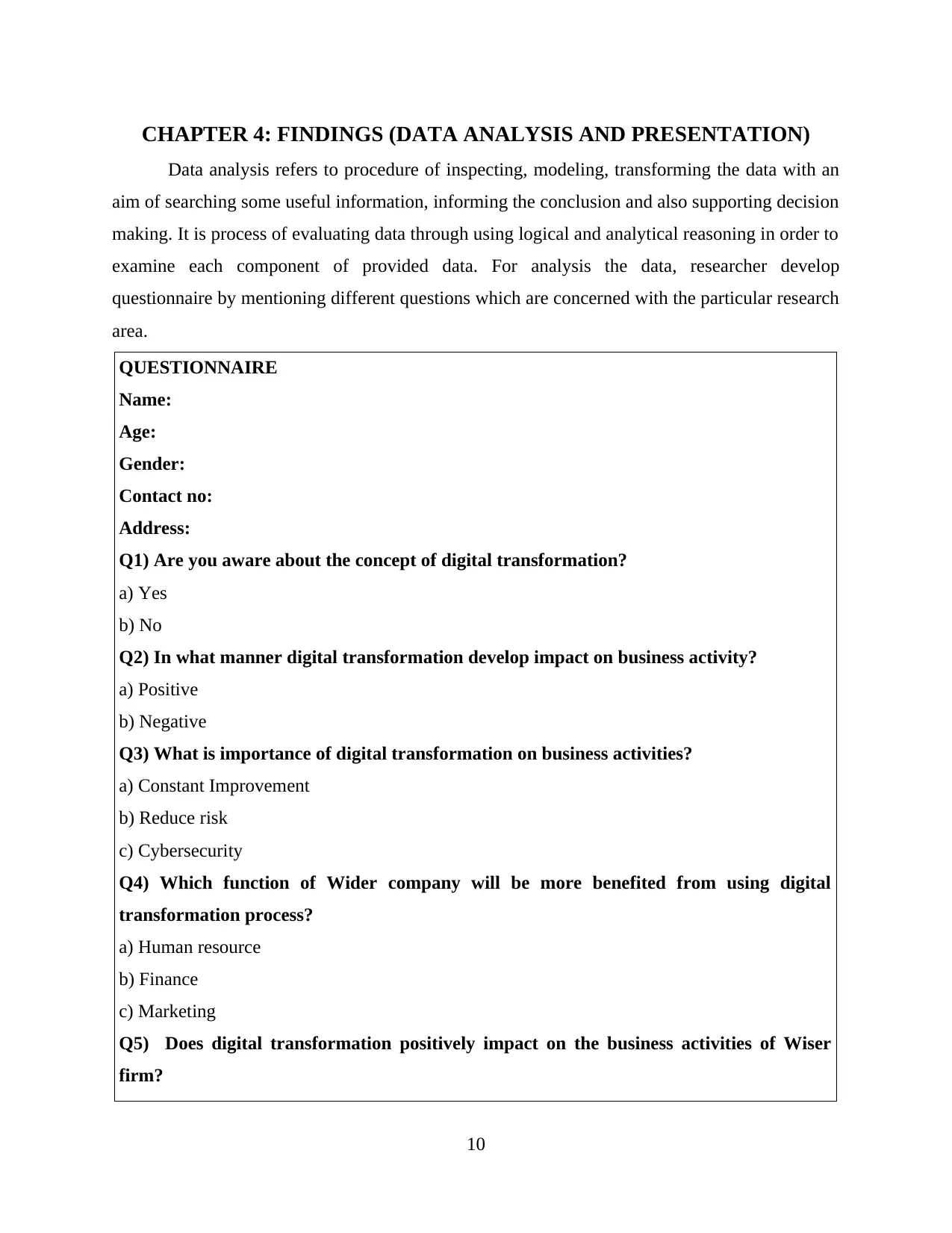
CHAPTER 4: FINDINGS (DATA ANALYSIS AND PRESENTATION)
Data analysis refers to procedure of inspecting, modeling, transforming the data with an
aim of searching some useful information, informing the conclusion and also supporting decision
making. It is process of evaluating data through using logical and analytical reasoning in order to
examine each component of provided data. For analysis the data, researcher develop
questionnaire by mentioning different questions which are concerned with the particular research
area.
QUESTIONNAIRE
Name:
Age:
Gender:
Contact no:
Address:
Q1) Are you aware about the concept of digital transformation?
a) Yes
b) No
Q2) In what manner digital transformation develop impact on business activity?
a) Positive
b) Negative
Q3) What is importance of digital transformation on business activities?
a) Constant Improvement
b) Reduce risk
c) Cybersecurity
Q4) Which function of Wider company will be more benefited from using digital
transformation process?
a) Human resource
b) Finance
c) Marketing
Q5) Does digital transformation positively impact on the business activities of Wiser
firm?
10
Data analysis refers to procedure of inspecting, modeling, transforming the data with an
aim of searching some useful information, informing the conclusion and also supporting decision
making. It is process of evaluating data through using logical and analytical reasoning in order to
examine each component of provided data. For analysis the data, researcher develop
questionnaire by mentioning different questions which are concerned with the particular research
area.
QUESTIONNAIRE
Name:
Age:
Gender:
Contact no:
Address:
Q1) Are you aware about the concept of digital transformation?
a) Yes
b) No
Q2) In what manner digital transformation develop impact on business activity?
a) Positive
b) Negative
Q3) What is importance of digital transformation on business activities?
a) Constant Improvement
b) Reduce risk
c) Cybersecurity
Q4) Which function of Wider company will be more benefited from using digital
transformation process?
a) Human resource
b) Finance
c) Marketing
Q5) Does digital transformation positively impact on the business activities of Wiser
firm?
10
⊘ This is a preview!⊘
Do you want full access?
Subscribe today to unlock all pages.

Trusted by 1+ million students worldwide
1 out of 24
Related Documents
Your All-in-One AI-Powered Toolkit for Academic Success.
+13062052269
info@desklib.com
Available 24*7 on WhatsApp / Email
![[object Object]](/_next/static/media/star-bottom.7253800d.svg)
Unlock your academic potential
Copyright © 2020–2025 A2Z Services. All Rights Reserved. Developed and managed by ZUCOL.




